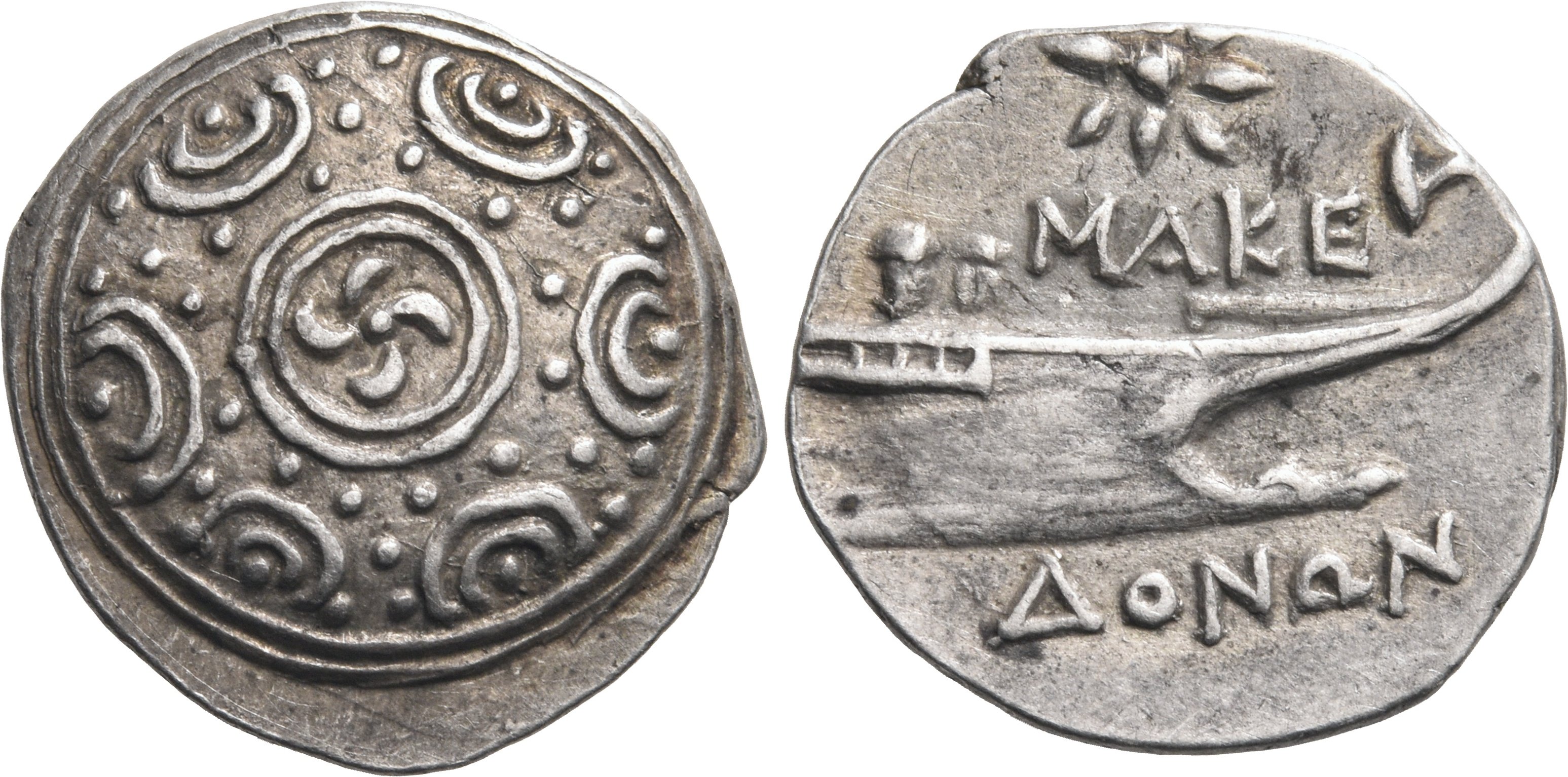S 1650 - Amphipolis (Macedonians), silver, hemidrachms (shield/stern) (221-197 BCE)
From SILVER
221 BCE - 197 BCE Silver 869 kg
Description
| ObverseInscription or printing placed on the obverse.: | Macedonian shield ornamented with six linear crescents around the edge and a tetraskeles of crescents at the center |
| ReverseInscription or printing placed on the reverse.: | ΜΑΚΕ / ΔΟΝΩΝ (Greek).Galley stern, above, star of eight rays |
Mint and issuing power
| MintIdentifies the place of manufacture or issue of a numismatic object.: | Amphipolis | Ancient regionAncient region.: | Macedonia | Modern countryModern country: Greece | AuthorityIdentifies the issuing power. The authority can be "pretended" when the name or the portrait of X is on the coin but he/she was not the issuing power. It can also be "uncertain" when there is no mention of X on the coin but he/she was the issuing power according to the historical sources: | Philip V of Macedonia (238-179 BCE) |
Chronology
| FromIdentifies the initial date in a range assigned in a numismatic context. | 221 BCE | toIdentifies the final date in a range assigned in a numismatic context.. | 197 BCE | PeriodTime period of the numismatic object.: Hellenistic 323-30 BC |
Physical description
| MetalThe physical material (usually metal) from which an object is made.: | Silver |
Median weightMedian of the weights of numismatic objects (in grams). in grams | 2.20 | DenominationTerm indicating the value of a numismatic object. Examples: tetradrachm, chalkous, denarius.: | hemidrachm |
StandardStandard.: |
Image

S1650 Macedonians hemidrachms shield stern.jpg [1]
References
| Die study referencePublication of the study: | Kremydi 20181Kremydi 2018, p. 69-74 | ||
| Coin series referenceReference to coin series study: | Sear I2Sear I, n° 1383 | ||
Obverse dies distribution
| FrequencyFrequency of specimen in distribution. ᵖ | Number of obversesNumber of obverse dies. ᵖ (o) | % (o) | Number of coinsNumber of coins. (n) | % (n) | Die nameName(s) of the die(s). |
| 1 | 3 | 16.67 | 3 | 3.13 | 7, 17, 18 |
| 2 | 2 | 11.11 | 4 | 4.17 | 14, 16 |
| 3 | 1 | 5.56 | 3 | 3.13 | 15 |
| 4 | 2 | 11.11 | 8 | 8.33 | 8, 9 |
| 5 | 8 | 44.44 | 40 | 41.67 | 1, 2, 4, 6, 10, 11, 12, 13 |
| 18 | 1 | 5.56 | 18 | 18.75 | 5 |
| 20 | 1 | 5.56 | 20 | 20.83 | 3 |
| Total | 18 of 18 | 100.01 | 96 of 96 | 100.01 |
Reverse dies distribution
no distribution is available
Quantification
| Number of obversesNumber of obverse dies. ᵖ (o) | 18 | Number of singletons (o1)The number of singleton coins. ᵖ | 3 |
| Number of reverse diesNumber of reverse dies. (r) | 35 | Number of coinsNumber of coins. (n) | 96 |
| Coins per obverse dieNumber of coins per obverse die. (n/o) | 5.33 | Coins per reverse dieNumber of coins per reverse die. (n/r) | 2.74 |
| Reverse per obverse ratioRatio of obverse dies divided by reverse dies. (r/o) | 1.94 | Percentage of singletons (o1)number of coins (n) divided by the number of singletons (o1) ᵖ | 16.67 % |
| Original number of dies (O) (Carter 1983 formula)The estimation of the number of coins according to Carter 1983 ᵖ | 19.76 | Coins struck if 20,000 as average productivity per dieCoins made if the average productivity for obverses (according to Carter) is 20,000. ᵖ | 395,200 |
| Original number of dies (O) (Esty 2011 formula)The estimation of the number of coins according to the singleton formula in Esty 2011 ᵖ (O) | 22.15 | Survival rate if 20,000 as average productivity per dieSurvival rate if average productivity is 20,000. ᵖ | 0.00024 |
| Coverage (o = % of O) (Esty 1984 formula)Esty 1984 - coverage (% of O) ᵖ (o = % of O) | 96.88% | Die productivity if survival rate 1/2,000Average productivity if survival rate is 1/2,000. ᵖ | 9,716.6 |
| Weight of silver (in kg) if 20,000 coins per die (O = Carter formula)Carter 1983 * Median weight * 20000 (*10 if gold or electrum) ᵖ | 869 kg <br /> 869 kg | Die productivity if survival rate 1/5,000Average productivity if survival rate is 1/5,000. ᵖ | 24,291.5 |
Remarks
Most likely one single workstation